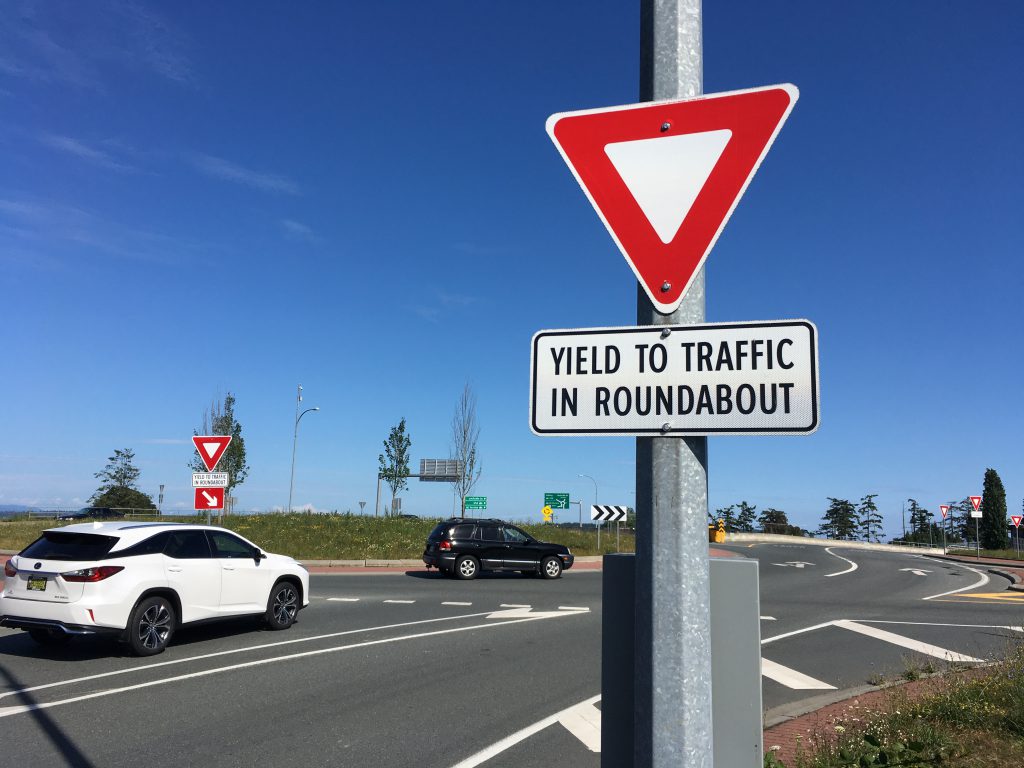
The rise of roundabouts in BC has set some people’s heads spinning on how to safely navigate them, whether as a driver, cyclist or pedestrian. So, we created the following guide to help set the record on roundabouts …er… straight.
There are more than 35 roundabouts on provincially maintained roadways across the province, but not all roundabouts are designed the same. Roundabouts can vary in size, number of lanes, and number of entrances and exits. Nevertheless, the same basic rules apply for all roundabouts.
How to Use Roundabouts
Drivers
There are two golden rules for entering an intersection controlled by a roundabout:
- Before entering, look left and yield to all traffic in the roundabout.
- When entering the intersection controlled by a roundabout, continue moving counter-clockwise and to the right of the rotary traffic island before exiting.
Multi-lane roundabouts at intersections have directional signs and pavement markings to help guide drivers. The signs offer a general depiction of the roundabout, complete with destination symbols (i.e. airport) and road names; they also show which lanes should be used for the various destinations. As you approach the intersection controlled by a roundabout, look at the signs to determine which lane you should be in. Get into the appropriate lane for your destination before entering the roundabout.
Now that you have chosen your lane, identified your destination’s exit, and yielded to pedestrians using the crosswalk, then come the golden rules stated above. This is the crux of any roundabout – get this right, and you’re in pretty good shape.
As you approach your exit, activate your right turn signal so pedestrians, cyclists and other drivers know your intentions.* And again, yield to pedestrians that may be crossing the exit lane’s crosswalk.
*More on signalling at the end of this blog
With Large Trucks
Roundabouts have what is called an “apron” encircling the centre island. This raised, coloured section allows longer, wider vehicles extra clearance when needed. Please remember to give large trucks lots of room to travel through roundabouts.
With Emergency Vehicles
If you are driving in a roundabout and you hear an emergency vehicle, do not stop! Continue through your intended exit and then pull over.
Cyclists
Cyclists have a couple choices when it comes to roundabouts.
- Use it like a vehicle: In advance of the roundabout, hand signal and merge with traffic when safe to do so, occupying the lane and proceeding into the roundabout as a vehicle would. Important reminder to drivers: cyclists have the right to use the full roundabout lane – be patient, and for goodness sake, no honking!
- Use the shared pathway: Before the roundabout, exit the bike lane on the ramp provided and share the pathway with pedestrians and other active transportation. Reduce your speed and be aware of others you’re sharing the pathway with. Dismount and use the marked crosswalks to cross the intersecting streets like a pedestrian. Exit the raised pathway at the ramp that leads down to the bike lane or shoulder of the road.
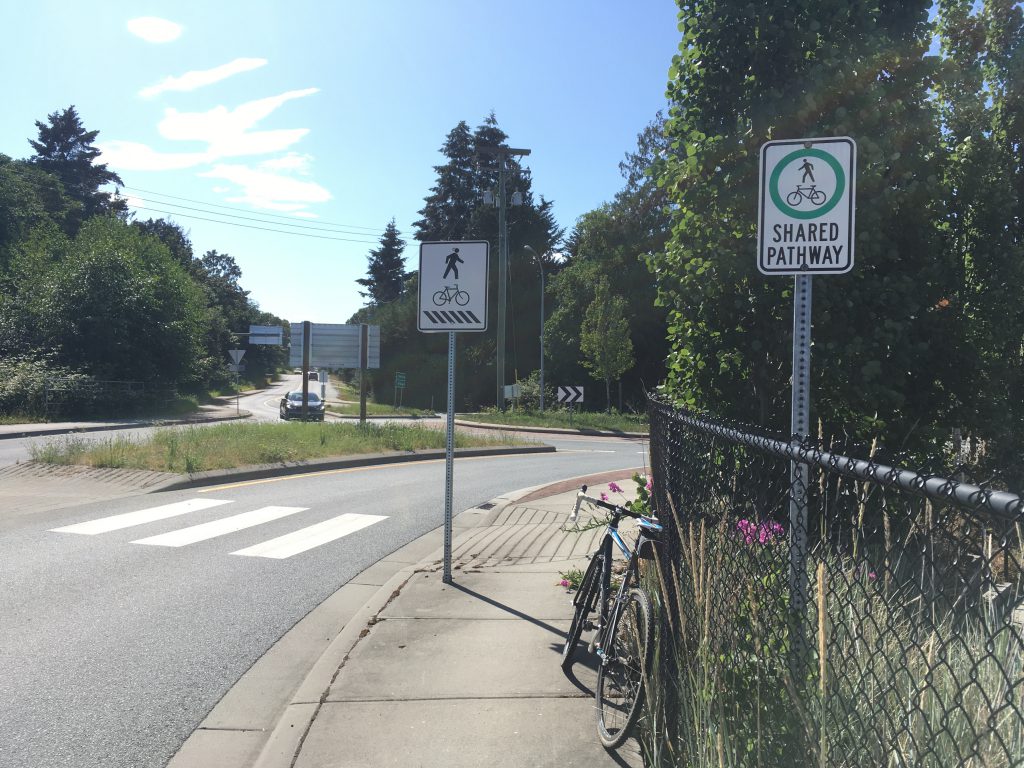
Pedestrians
Pedestrian crosswalks with pavement markings are located about one car length away from the roundabout. It’s important to only cross at these marked locations; don’t get stranded by cutting across to the central island (there’s really no reason to be there and it’s not safe).
Although vehicles are required to yield to pedestrians, you shouldn’t initiate a crossing unless there’s an adequate gap in traffic or all approaching vehicles have stopped. It’s important to note that a dedicated bicycle path may also connect to these crosswalks – be aware that you’re sharing the crosswalk and pathways with cyclists.
Why Roundabouts?
Intersections controlled by roundabouts are increasingly becoming a go-to design. So, why are they being used more? It comes down to, what we like to refer to, as the bread and butter of transportation: safety and traffic flow.
Roundabouts keep people moving and can reduce backups during heavy traffic volumes. Less traffic standing still means less emissions from idling engines, too. Also, roundabouts reduce the number of conflict points over signalized intersections, thereby decreasing the severity of collisions.
Roundabouts are used when engineering and traffic analysis determines they will provide improved safety and traffic flow for users. Some considerations include traffic volumes, number of intersecting roads, land/cost requirements and collision history.
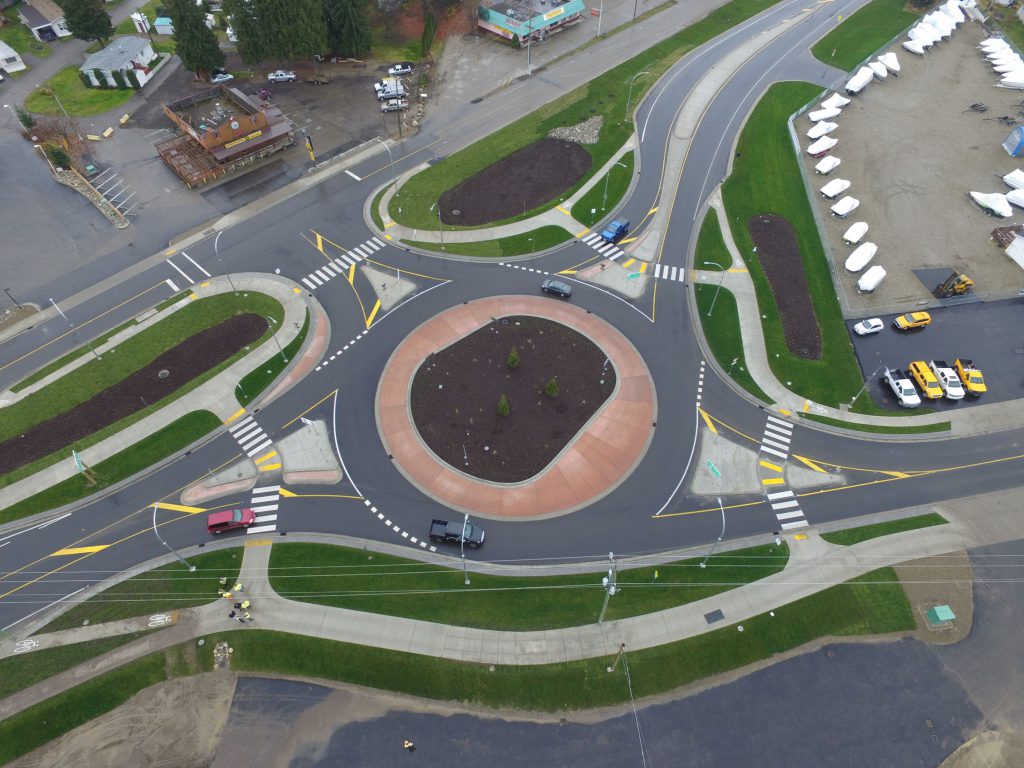
History of Roundabouts in BC
While circular intersections (rotaries) existed in North America since the early 1900s, the modern roundabout was born out of the United Kingdom in the 1960s, before emerging in Canada in the 1990s.
One of the first modern roundabouts built on a provincial road in BC is the double roundabout on Eighth Avenue, just off Highway 99 and west of Highway 15, near the US border. This location, which opened in 2005, features two roundabouts on either side of the interchange.
In 2011, one of BC’s largest networks of roundabouts opened to traffic on Highway 17 at McTavish Road just south of Sidney. Previously a signalized intersection, a combination of three roundabouts improved traffic flow to and from the Victoria International Airport, the Swartz Bay ferry terminal, and the rest of the Saanich Peninsula. The roundabout network also incorporates a six-bay transit exchange and 200-stall park and ride lot.
Some more recent examples of roundabouts include:
- Highway 1 at McCallum Road in Abbotsford – two multi-lane roundabouts and a four-lane overpass replaced the two-lane bridge over the Trans-Canada Highway, improving access to and from the city. Work was completed in 2011.
- Highway 97 six-laning project in Kelowna – a roundabout was used on the side road realignment at Rutland/Old Vernon to improve access and keep traffic moving through the area. Work was completed in 2018.
- Highway 16/37 near Terrace – construction of a roundabout to replace the existing four-way stop is underway with completion expected in late 2020.
- Highway 93/95 in Radium Hot Springs – the current four-way stop results in heavy backups, especially during the peak summer months. Roundabout construction started June 1, 2020, and is expected to be completed in fall 2020.
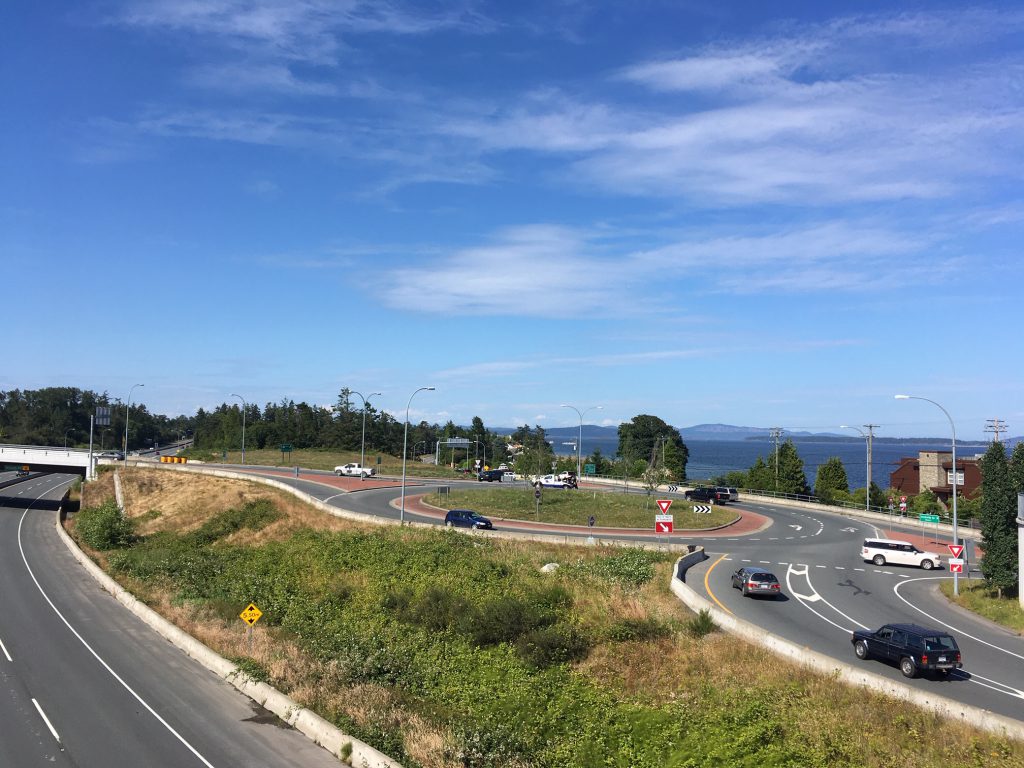
Signalling at Intersection Controlled by Roundabouts
As roundabouts have become more and more popular, proper signalling in roundabouts has become a bone of contention. That’s partly because signalling in roundabouts is not specifically covered in the BC Motor Vehicle Act, the authority on driving.
There are, however, relevant sections: Section 170 and Section 150 (3).
As ICBC states in their Learn to Drive Smart Manual, signalling right before exiting a roundabout is beneficial, as following vehicles know your intent to exit. Signals when turning is included in the BC MVA: “If a signal of intention to turn right or left is required, a driver must give it continuously for sufficient distance before making the turn to warn traffic.”
That means, when entering an intersection controlled by a roundabout:
- If intending a right turn: Signal right on approach, and continuously signal right until the right turn is complete.
- If intending to drive straight through (i.e. you’re not turning right or left at the intersection): No signal until exiting – then signal right to exit, as per ICBC’s recommendation.
- If intending a left turn: Signal left on approach, and continuously signal left until approaching the exit. Signal right to exit, as per ICBC’s recommendation.
This view is shared by other countries, such as the UK, and it is our recommendation. That said, it would be a victory in and of itself if drivers at least signalled right before exiting roundabouts. We see many drivers that do not signal at all – whether entering or exiting – roundabouts.
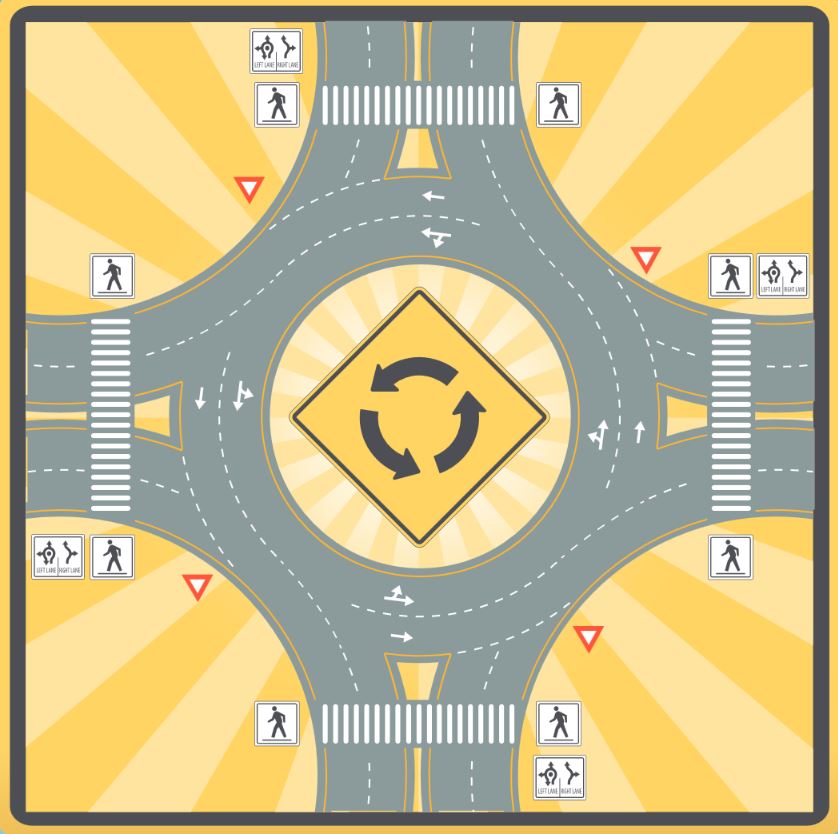
You can also check out the following helpful blogs:
>> How the Lions Gate Bridge Counterflow Works
>> Top 3 Ways to Be Truck Aware
>> Traffic Signal Power Outage! What Do You Do?
Have we left anything out? If so, let us know in the comments section below.
Join the discussion